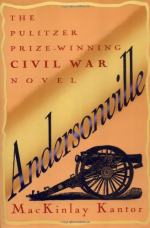“It was an awful night. Down in the ravine below us lay hundreds of killed and wounded Rebels, groaning and crying aloud for water and for help. We did do what we could for those right around us—but it was so dark, and so many shell bursting and bullets flying around that a fellow could not get about much. I tell you it was pretty tough next morning to go along to the different companies of our regiment and hear who were among the killed and wounded, and to see the long row of graves that were being dug to bury our comrades and our officers. There was the Captain of Company E, Nelson Skeeles, of Fulton County, O., one of—the bravest and best officers in the regiment. By his side lay First Sergeant Lesnit, and next were the two great, powerful Shepherds—cousins but more like brothers. One, it seems, was killed while supporting the head of the other, who had just received a death wound, thus dying in each other’s arms.
“But I can’t begin to think or tell you the names of all the poor boys that we laid away to rest in their last, long sleep on that gloomy day. Our Major was severely wounded, and several other officers had been hit more or less badly.
“It was a frightful sight, though, to go over the field in front of our works on that morning. The Rebel dead and badly wounded laid where they had fallen. The bottom and opposite side of the ravine showed how destructive our fire and that of the canister from the howitzers had been. The underbrush was cut, slashed, and torn into shreds, and the larger trees were scarred, bruised and broken by the thousands of bullets and other missiles that had been poured into them from almost every conceivable direction during the day before.
“A lot of us boys went way over to the left into Fuller’s Division of the Sixteenth Corps, to see how some of our boys over there had got through the scrimmage, for they had about as nasty a fight as any part of the Army, and if it had not been for their being just where they were, I am not sure but what the old Seventeenth Corps would have had a different story to tell now. We found our friends had been way out by Decatur, where their brigade had got into a pretty lively fight on their own hook.
“We got back to camp, and the first thing I knew I was detailed for picket duty, and we were posted over a few rods across the ravine in our front. We had not been out but a short time when we saw a flag of truce, borne by an officer, coming towards us. We halted him, and made him wait until a report was sent back to Corps headquarters. The Rebel officer was quite chatty and talkative with our picket officer, while waiting. He said he was on General Cleburne’s staff, and that the troops that charged us so fiercely the evening before was Cleburne’s whole Division, and that after their last repulse, knowing the hill where we were posted was the most important position along our line, he felt that if they would keep close to us during




